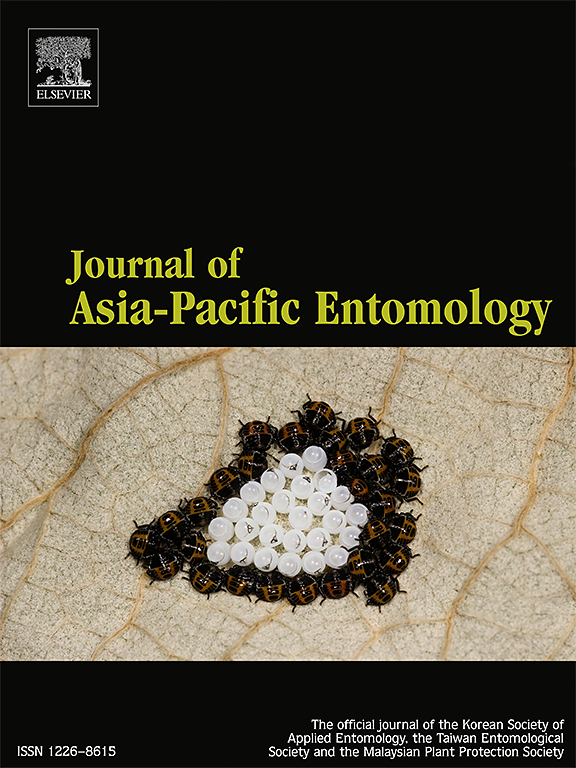Differential susceptibility of Riptortus pedestris (F.) and its two egg parasitoids to flonicamid
IF 1.1
3区 农林科学
Q3 ENTOMOLOGY
引用次数: 0
Abstract
Flonicamid a systemic insecticide acts as a feeding inhibitor against sucking insect pests. Now it is registered against soybean aphids in Korea and can be also used to control Riptortus pedestris (F.), a major pest of soybean. Here, we compared the susceptibility of R. pedestris and its two egg parasitoids, Ooencyrtus nezarae Ishii and Gryon japonicum (Ashmead), to flonicamid. The median lethal concentrations for 2nd and 4th instar nymphs of R. pedestris were 0.03 and 1.3 g/L, respectively, after 48 h of feeding. The toxicity indices for 2nd and 4th instar nymphs, and adult R. pedestris fed with 0.5 g/L flonicamid were 1.8, 1.5, and 1.5 times more toxic than that of the water control, while those for O. nezarae and G. japonicum were just 1.1 and 1.2 times more toxic than that of the control, respectively. In conclusion, flonicamid is more toxic to nymphs than adult stages of R. pedestris, but it is relatively safe to its egg parasitoids, thus can be used as an effective strategy for conservation biological control against R. pedestris.

步蝇及其两种卵寄生蜂对氟虫胺的敏感性差异
氟虫胺是一种系统杀虫剂,具有抑制吸吮性害虫取食的作用。目前在国内已登记为防治大豆蚜虫的药剂,而且还可以防治大豆的主要害虫——步行曲蝇(Riptortus hidstris)。本研究比较了黄颡鱼及其两种卵类寄生物黄颡鱼卵通虫(Ooencyrtus nezarae Ishii)和日本黄颡鱼卵通虫(Gryon japonicum, Ashmead)对氟虫胺的敏感性。摄食48 h后,2龄和4龄小野田鼠若虫的中位致死浓度分别为0.03和1.3 g/L。0.5 g/L氟硝胺对2龄、4龄若虫和成虫的毒性分别是对照的1.8倍、1.5倍和1.5倍,而对麻纹姬鼠和日本姬鼠的毒性分别是对照的1.1倍和1.2倍。综上所述,氟虫胺对瓢虫若虫的毒性大于成虫,但对瓢虫卵的寄生蜂相对安全,可作为瓢虫保护生物防治的有效策略。
本文章由计算机程序翻译,如有差异,请以英文原文为准。
求助全文
约1分钟内获得全文
求助全文
来源期刊

Journal of Asia-pacific Entomology
Agricultural and Biological Sciences-Insect Science
CiteScore
2.70
自引率
6.70%
发文量
152
审稿时长
69 days
期刊介绍:
The journal publishes original research papers, review articles and short communications in the basic and applied area concerning insects, mites or other arthropods and nematodes of economic importance in agriculture, forestry, industry, human and animal health, and natural resource and environment management, and is the official journal of the Korean Society of Applied Entomology and the Taiwan Entomological Society.
 求助内容:
求助内容: 应助结果提醒方式:
应助结果提醒方式:


